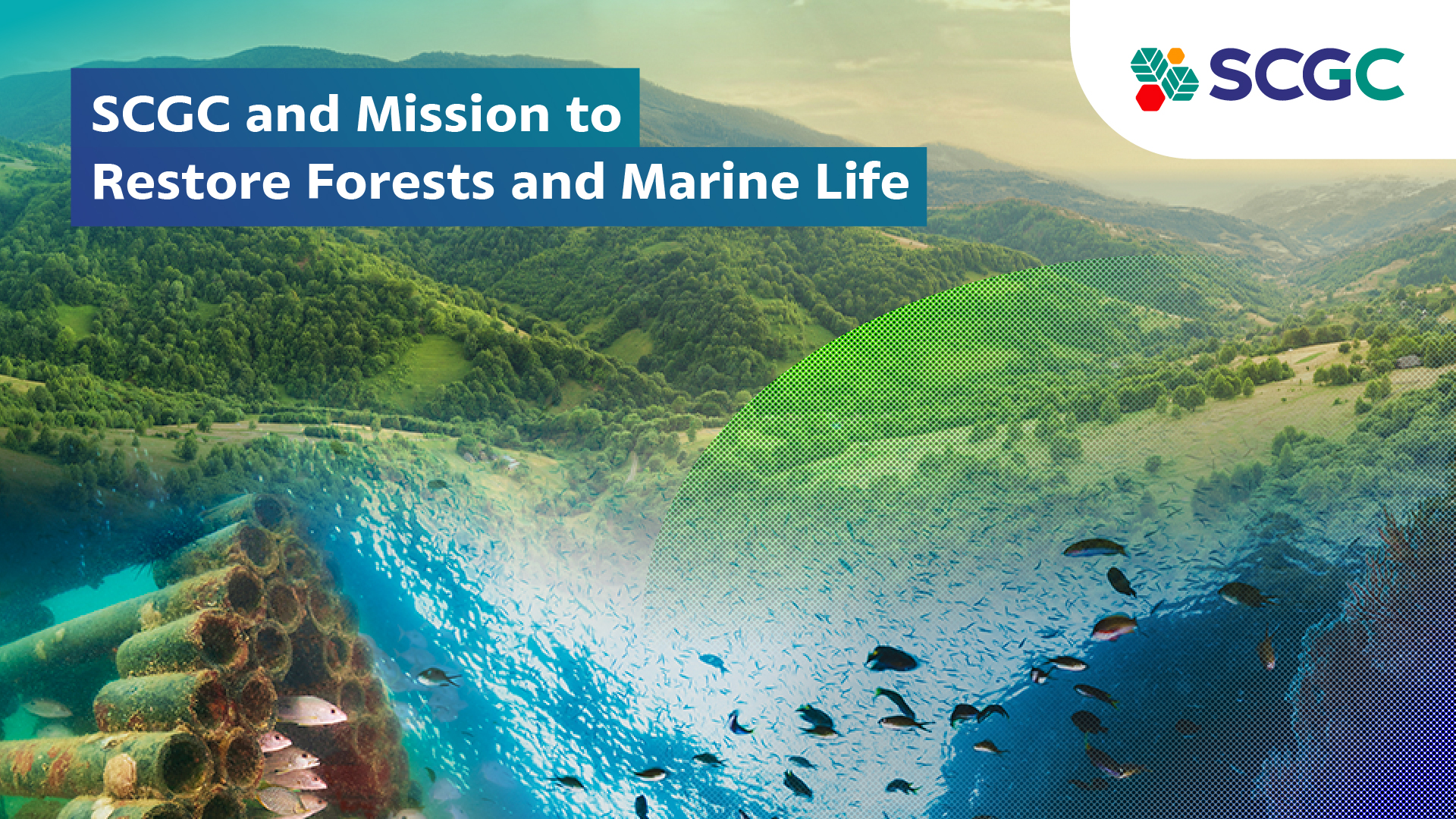Transforming drought land into year-round water haven, fostering a low-carbon society, revitalizing local fishing, and restoring marine life through SCGC's impactful sustainable environmental initiatives.
Forests and water are inseparable natural resources. It is said that where there are forests, there is water. Forests are the source of water that flows and nourishes all life, passing through the homes of various creatures, communities, and thenreaching the ocean.
SCG Chemicals, or SCGC, recognizes the importance of forests and water resources. This understanding has led to initiating our environmental sustainability projects, aiming to contribute to reducing global warming and improving the quality of life in communities following ESG principles. From planting seedlings and reforesting to developing water sources and creating marine ecosystems, our efforts have brought smiles and improved well-being to local people.
SCGC would like to share stories of our mission to restore forests and return fish to the ocean through environmental sustainability projects.
----------------------------------------------------------------------------------------------------------------------------------------
MORE STORIES FROM SCGC:
✓ How to regain mental fortitude and readiness to combat "climate anxiety"?
✓ Corporate Governance is Engine That Drives SCGC’s Business
✓ Discover Chemical Innovation Highlights That Meet Global Megatrends
----------------------------------------------------------------------------------------------------------------------------------------
The Community of Good Water Management: Securing Water with the "2 Cultivate 2 Collect" Model
"In the past, Khao Yai Da wasn't like this. Years ago, we experienced drought due to deforestation. We tried to reforest but weren't very successful until we collaborated with SCG Chemicals. They taught us about water management, and they became our mentors, offering advice whenever we faced problems,"
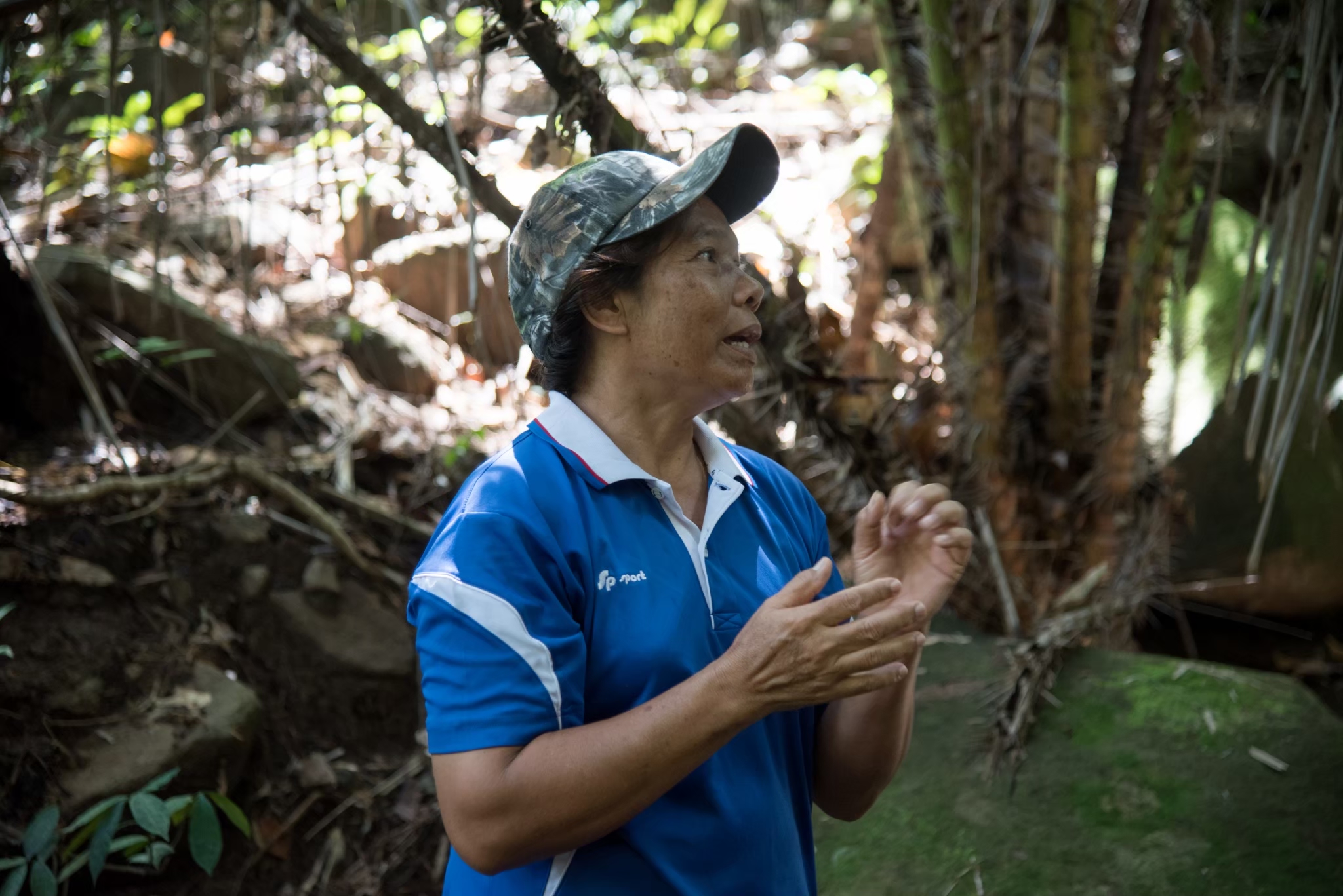
Wandeet Itthaprom, the village head of Ban Mabchan, Rayong Province recalled the background before collaborating with SCGC to transform the area around Khao Yai Da into a thriving and flourishing environment. In 2007, SCGC became the community's mentor, providing consultation on environmental restoration for the Khao Yai Da community. This partnership led to the " 2 Cultivate 2 Collect: Secure Water with Good Management" project, a life-changing initiative for the villagers of Ban Mabchab, which focused on systematic water management to combat drought. The project's core principles are: "Cultivate human potential" by fostering local researchers to work with SCGC and experts; "Cultivating rules" to ensure sustainable water usage based on mutual understanding; "Collecting data" by systematically recording water levels at various points for rule-setting; and "Collecting water" by maximizing water storage through the maintenance of water sources and community reservoirs.
The " 2 Cultivate 2 Collect " model was implemented alongside conservation efforts for forests and water. It began with the restoration of upstream forests by planting five-tier forests or selecting local plants with different canopy levels. These included underground plants like yams and taro, ground-level plants like pumpkin and watermelon, short plants like chili and eggplant, medium-sized plants like mango and coconut, and tall plants like teak and rubber trees. These were planted alongside the original forest to reduce rainwater impact on the soil and maximize the soil's water absorption. The efforts also include the construction of natural-material check dams to collect water and slow down its flow during the rainy season. Additionally, digging canals to store water for use, and finally, creating underground water banks by digging holes to store rainwater underground, providing moisture to the soil. This saves water for irrigating trees and agricultural crops, reduces flooding during the rainy season, and maintains moisture during the dry season.
SCGC stands alongside the community to collaboratively address forest and water issues sustainably, resulting in over 10 years of accumulated knowledge gained through mentoring the villagers of Ban Mabchan. This has led to significant environmental outcomes, including replenishing water resources by an additional 14.83 million cubic meters per year, reducing the annual average temperature by 1.6 degrees Celsius, storing 38.49 tons of carbon dioxide per rai, and discovering 123 wildlife species and over 120 plant species. These accomplishments do not consider the immeasurable happiness and smiles of the community members, who hold immense value in themselves.
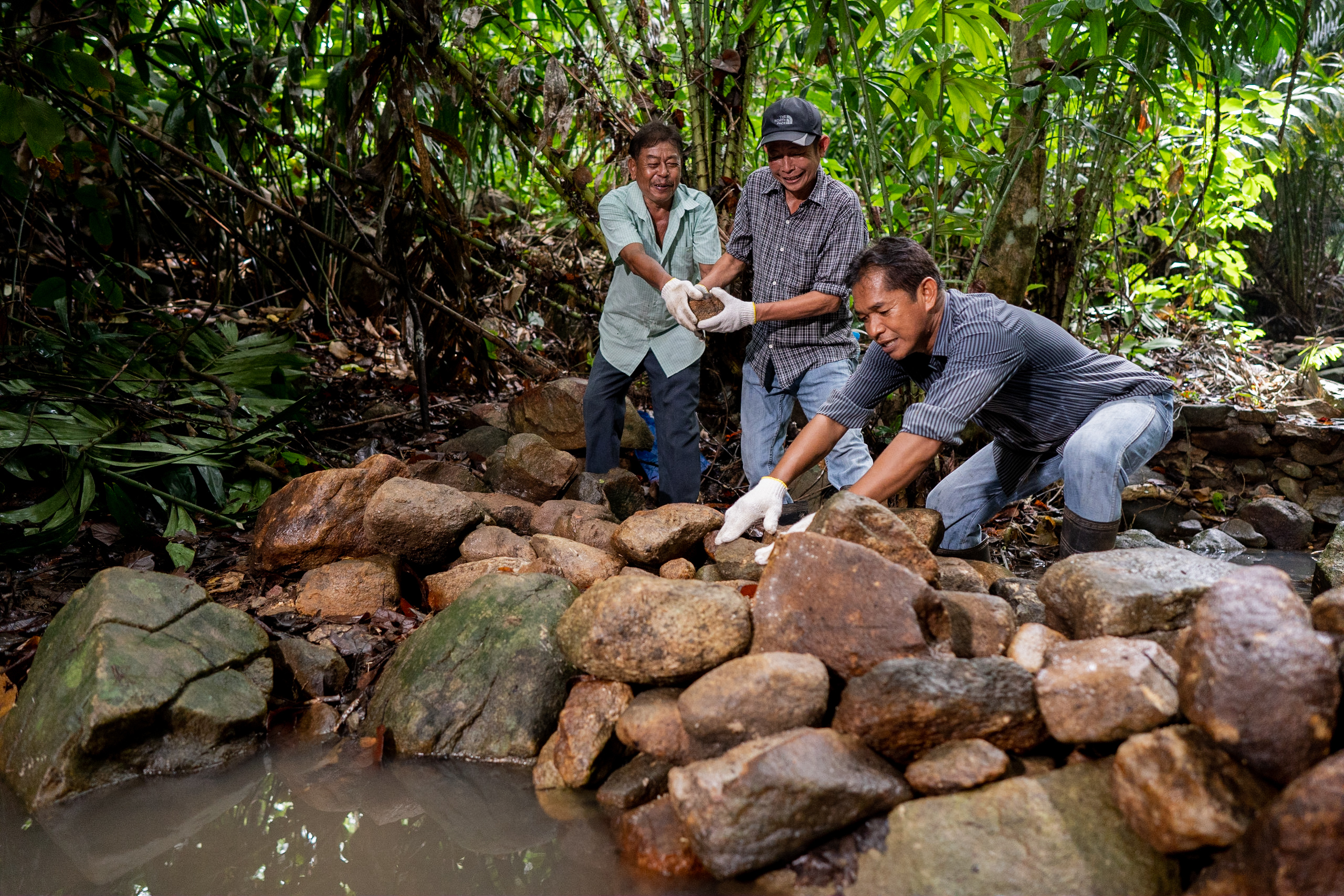
Plant-Cultivate-Protect Campaign: Plant Trees, Cultivate Seedlings, Protect the Forest, and Promote Low Carbon Society.
In addition to the area around Khao Yai Da, SCGC recognizes environmental issues in various parts of Rayong province and takes on the mission to address and concretely resolve these problems. For instance, in the case of forests, SCGC has continuously supported reforestation, transforming thousands of rai of land into green space, with hundreds of thousands of trees planted through collaboration with all sectors, enriching the land with lush vegetation.
From the commitment to creating a low-carbon society through years of reforestation efforts, SCGC has launched an environmental project called the " Plant-Cultivate-Protect Campaign." This initiative focuses on planting trees, cultivating seedlings, and protecting forests – three crucial principles for building a sustainable environment.
Planting trees: SCGC collaborates with government agencies, the private sector, educational institutions, youth, local communities, and volunteers to restore forests to their abundant state. This is done by planting mangroves, conserving community forests, and continuously planting trees in public areas for the benefit of absorbing carbon dioxide, serving as a large lung for the people in the area, and providing a complete ecosystem for various animals. Initially, SCGC planted 161,100 ต้น mangrove trees and other species in mangrove forest areas, covering 230 rai of land, which can absorb up to 2,189 tons of carbon dioxide This is just the beginning of the mission, as SCGC aims to plant 1 million trees, and the number of seedlings planted in the ground is gradually increasing.
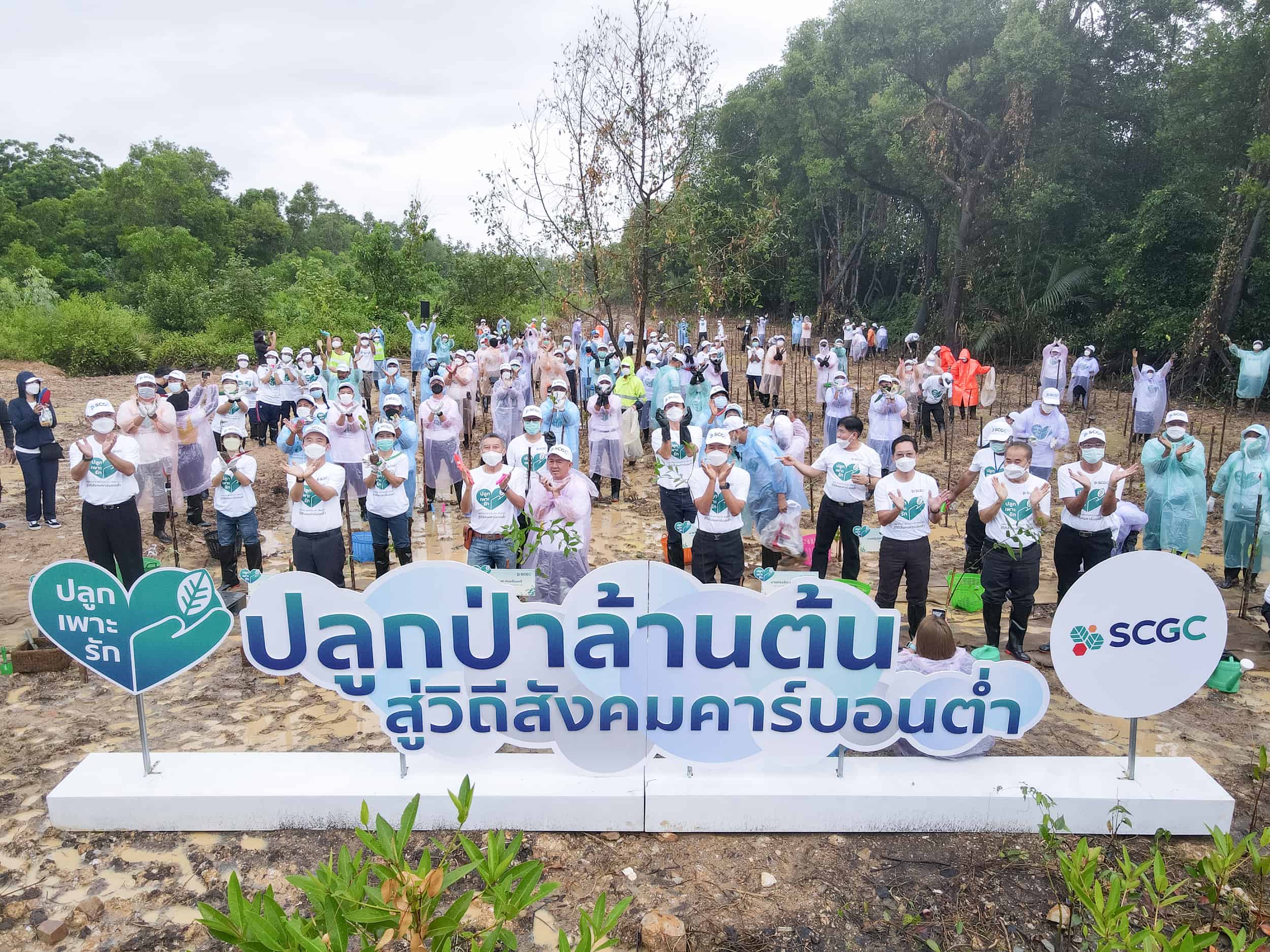
Cultivating seedlings: From the starting point of restoring the forest area around Khao Yai Da, SCGC has collaborated with local communities to create a seed bank by collecting local and rare tree species seeds. A nursery was set up to propagate seeds from the trees in the Khao Yai Da area, while also sharing seeds with the public to cultivate and return the seedlings to the nursery for proper care, ensuring they grow strong and are ready to be planted. So far, more than 20,100 seedlings have been cultivated. (*as of February, 2023)
Protecting the forest: In addition to planting trees in the ground, planting trees in people's hearts is equally important. SCGC supports projects that foster a sense of love for forests, promoting harmonious coexistence between people and forests. This is achieved through collaboration with agencies that share common missions and a network of local volunteer conservation groups. These groups continuously organize activities to care for forest areas, recruit new members to continue the work of the network, and jointly lead forest conservation efforts into the future.
Fish homes: From Small Marine Animal Shelters to Sustainable Fishing Communities
"Small-scale fishing" is an occupation that has long sustained the people of Rayong province from generation to generation. Local fishers venture out to sea in the early morning every day to catch marine animals for sale. Their livelihoods depend on the abundance of marine resources.
However, one day, small boats had to sail further and further away from the shore due to the decline of coastal resources. The marine life near the shore was no longer sufficient to support the livelihoods of local fishers. The impact of shrimp farming and some improper commercial fishing practices forced them to travel greater distances, spend more time, and incur higher fuel costs, all while facing strong winds and waves that damaged their equipment.
Determined to improve community members' quality of life and protect the environment, SCGC collaborated with the Marine and Coastal Resources Office 1 (Rayong) and the Rayong fisherfolk groups to address these issues by restoring fish populations with the creation of "fish homes." These fish homes are made from PE100 pipes, manufactured from high-quality plastic resins left over from testing processes in plants. PE100 plastic resins are certified to be environmentally friendly, UV resistant, and water pressure resistant. They are used to produce large drinking water pipes, making them safe for marine ecosystems. After being deployed, no microplastics from the PE100 pipes were found in the vicinity of the fish homes or the surrounding areas.
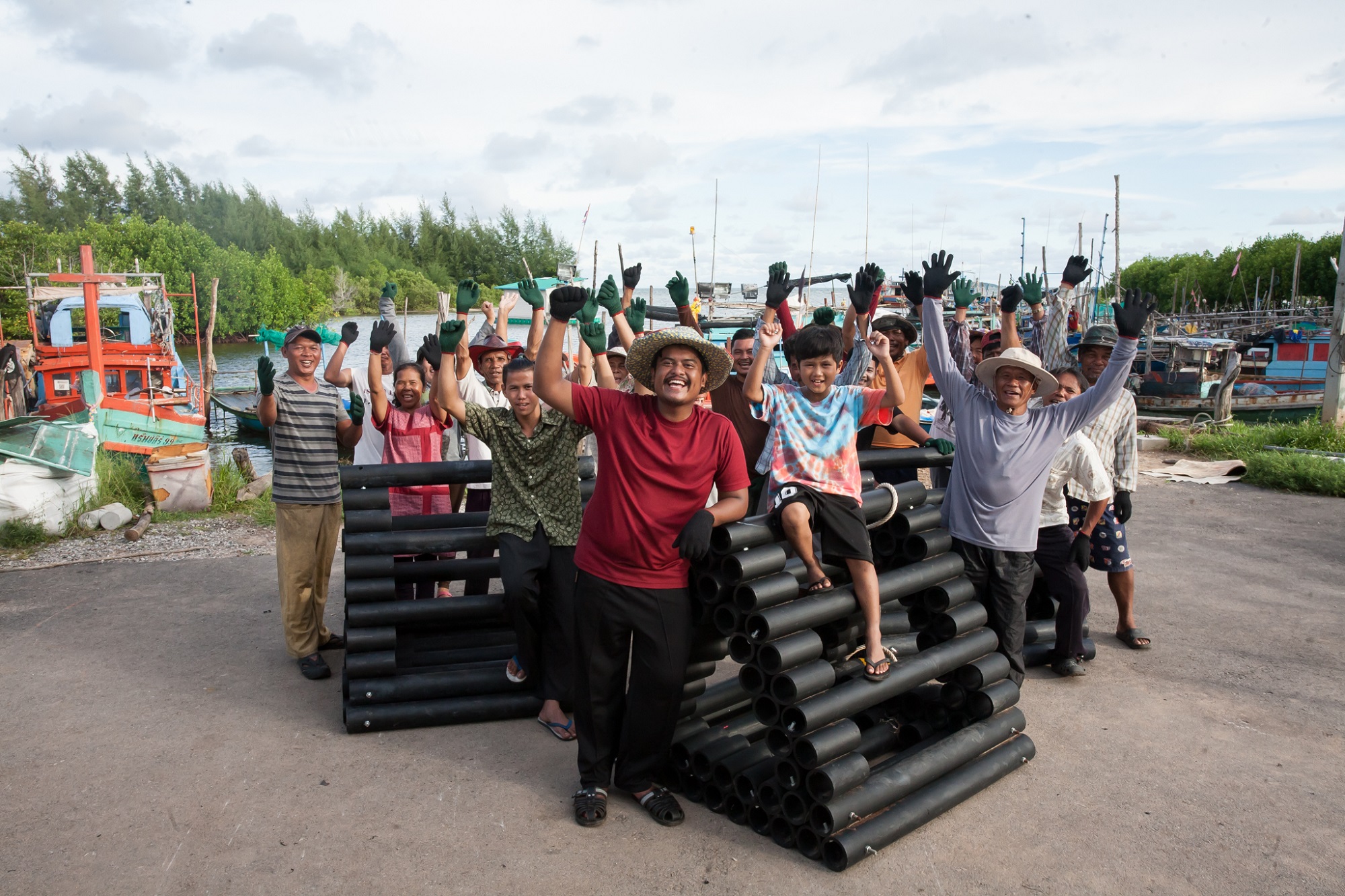
Since the first fish home was installed at the mouth of the Klaeng River in Rayong province in 2012, SCGC has deployed over 2,230 fish homes, creating more than 50 square kilometers of marine conservation areas. This effort has led to collaborations with 43 local fisherfolk groups, providing additional income for more than 930 small-scale fishers in the Rayong coastal area and generating over 9 million baht in annual revenue for the fishing communities (*data from an SROI survey of 10 traditional fishing groups in Rayong province in 2022).
When forests and water sources are inseparable, sustainable environmental care must prioritize natural resources in all dimensions. This includes revitalizing forests to be lush and abundant, managing water resources efficiently, and preserving marine ecosystems. All of these efforts aim to foster harmony and happiness among all living beings amidst a healthy environment. As a result, people can enjoy a good quality of life under the continuous implementation of ESG principles by SCGC.



